Illustration. Comics. Artdump. For commissions open: [email protected]
Don't wanna be here? Send us removal request.
Text

Private commission: one big, gnarly, pterosaur kaiju worshipped as a God.
#dinosaur#kaiju#pterosaur#pteranodon#cavemen#cavemen and dinosaurs#pen and ink#illustration#my art#rpg#indie rpg
7 notes
·
View notes
Text

"Nausea". I thought I'd have some fun with weird perspectives and the sense that nothing is left of you but chattering, sickening agitation.
4 notes
·
View notes
Text

A captain of ghouls at the battle for the Jagged Rock, War of the Ghouls and Moon-beasts.
Ghouls amuse themselves by appropriating the martial pomp of mankind; they especially like gaudy pieces from armies they found to be delicious or funny.
Note the dessicated fingers and crystal decanter of liquefied bathtub-murder victim brought along as snacks.
A canteen fashioned from skull halves facilitates urine marking, an indispensable social activity for the well-to-do gentleghoul.
#my art#cthulhu mythos#h p lovecraft#cthulhu#lovecraft#dream quest of unknown kadath#dreamlands#fantasy#ghouls
52 notes
·
View notes
Text

A ghoulish peltast of Pickman and Carter's legion from the battle against the Moon-Beasts at Jagged Rock and after.
Having familiarised herself with javelins, this adult female wields a gnawed-at femur as a spear thrower for improved range. The types used at the time were improvised; afterwards they were ornamented with filigree in dental gold and locks of dead bride's hair.
Note that she has urinated upon the ground to make it soft enough to stand spare missiles in, to identify herself to other ghouls by scent, and to clog the tips up with noxious filth.
A weapon used sparingly at the time used a mummified arm to assist in the hurling of urn bombs - a weapon that spreads thick clouds of toxic, choking gas derived from extremely vile substances harmless to ghouls. This would, in time, gain prominence as a crucial means of screening the advance of ghoulish war and raiding parties.
#my art#cthulhu mythos#h p lovecraft#lovecraft#dream quest of unknown kadath#cthulhu#dreamlands#fantasy#ghouls
21 notes
·
View notes
Text

Grishnákh, captain of Mordor. (Also book accurate!)
'Nazgûl, Nazgûl', said Grishnákh, shivering and licking his lips, as if the word had a foul taste that he savoured painfully. 'You speak of what is deep beyond the reach of your muddy dreams, Uglúk.' "a voice, softer than the others, but more evil" "a short crook-legged creature, very broad and with long arms that hung almost to the ground" (LoTR, The Uruk_Hai) In the third chapter of J.R.R. Tolkien's The Two Towers, Grishnákh, leading Orcs of Mordor, vies unsuccessfully with Uglúk, an Uruk-Hai captain from Isengard, to deliver Merry and Pippin to his master. He's a rather interesting fellow for someone only with us until a Rider of Rohan cuts him down; he seems to have been present at the interrogation of Gollum, he's aware of the winged fell beasts prepared for the Nazgûl but hidden from the world, he even seems to know of the great ring- all in all this is a very dangerous orc to know, and one who seems disturbingly close to Sauron. I've wound up drawing the "non-Uruk" breeds of Orc as very akin to Australopithocenes, with heads naturally shaped in ways reminiscent of Hunnic cranial deformation. Scimitar, jagged knife with ugly pommel, iron shod (hobnailed) boots based on late Roman types are close to text; the arm defences aren't out of line with the notional late-antiquity/early medieval/migration era historical basis of middle-earth (Roman and Persian heavy cavalry used similar) but they are a bit fanciful- well, he's a high status and very nasty fellow!
#tolkien#my art#orc#lotr orcs#orcs#fantasy#lotr fanart#lord of the rings#the two towers#australopithecus#Huns
16 notes
·
View notes
Text

From the sketch-heap: book-accurate Uglúk, captain of the Uruk-Hai. "There were four goblin-soldiers of greater stature, swart, slant-eyed, with thick legs and large hands. They were armed with short broad-bladed swords, not with the curved scimitars usual with Orcs; and they had bows of yew, in length and shape like the bows of Men. Upon their shields they bore a strange device: a small white hand in the centre of a black field; on the front of their iron helms was set an S-rune, wrought of some white metal." (LOTR, The Departure of Boromir)
"We are the fighting Uruk-Hai! We slew the great warrior. We took the prisoners. We are the servants of Saruman the Wise, the White Hand: the hand that gives us man's-flesh to eat. We came out of Isengard, and led you here, and we shall lead you back by the way we choose. I am Uglúk. I have spoken." (LOTR, The Uruk-Hai)
Jackson's films are gorgeous, but they take some liberties in the look of Middle-Earth and its' denizens; chiefly, in their material culture. The Weta team settled in on a lot of arms and armours from the late middle ages and renaissance- plate armour, sallets, crossbows, German longswords- but Tolkien drew his inspiration from late antiquity and the earlier middle ages; the time of myths like the Nibelungenlied, Beowulf, the Norse sagas, and the history of figures like Attila, Justinian, Theodoric, and so on, which heavily inform the content of his stories. It's all mail, all the time! I've given Uglúk's gear a rather Roman cast owing to that short, broad sword bit; his helmet is a late Roman "intercisa" type, simple and suited for mass-production, adorned with a Cirth-rune S. I'm a bit torn between gladius types, straight and leaf, and the rather exciting, potent cutter that is the Congolese Ikakalaka. I'm not completely satisfied with those shields, yet, but I like the idea of letters and numerals added to differentiate units and track personnel. Arguably, someone carrying a substantial warbow should restrict themselves to an easily-carried buckler. If you're wondering about how he's carrying his arrows, it's an in-battle method used by English longbowmen; as you twist your body to one side, the become easily reached.
#tolkien#lord of the rings#lotr orcs#lotr#lotr fanart#uruk hai#uruk#orc#two towers#saruman#Isengard#fantasy#my art
45 notes
·
View notes
Text
Where do little orcs come from?
Squat, crook-legged, long armed, stooping, sallow, appearing as deeply unflattering charicatures of the feared Huns and Mongols, boiling out of dark caverns with curved swords, horn bows, and hide shields, clad in ugly but effective mail, Tolkien's orcs are both iconic, and very seldom depicted with any accuracy at all. They aren't green, nor professional wrestlers, they lack tusks, they aren't wearing plate armour, they're devious rather than stupid, and they resemble neither toads nor boars (to call out Rankin-Bass and the borthers Hildebrandt) We're left wondering, if we've read his work, how they might really look onscreen, and where he got the visual idea from. Both questions are easily answered. All you need to do is sit down with your favourite mega-budget fantasy blockbuster; Fritz Lang's Die Nibelungen 2: Kriemhilds Rache (1924)! Seeking vengeance for the death of Siegfried, and prepared to play the long game, Kriemhild marries Attila the Hun, and, minus red eyes and fangs, they line up with almost every piece of descriptive text in the canon.













A brief shout-out is due to Attila, father of the year (447 AD)




Honestly, he's a tragic hero in this film. Should've stayed well clear of those treacherous, cruel Germanics.
Disclaimer: there are more influeces out there on Tolkien's orcs, but holy fuck this film's dead on.
#tolkien#jrr tolkien#lord of the rings#lotr orcs#orc#goblins#huns#fritz lang#the fellowship of the ring#the return of the king#two towers#fantasy#attila the hun#Fritz Lang#silent film#die nibelungen#kriemhild
4 notes
·
View notes
Text

Private commission; an Oni with his kanabo. Unfortunately a fairly surface take- time did not permit a really deep dive into the stories and symbols behind our squashy guys!
80 notes
·
View notes
Text
Tolkien and the Eagles of Orleans
Our hapless artistic genius recently wasted a couple of hours on this fine tome from 1915:

It's... of its time. A fairly breezy recounting of Attila the Hun and his campaign into France is, with zero chill or subtlety, set up as the prototype of today's Hun: the "Turanian", vaguely Asiatic Prussian-German hellbent on the destruction of Western Civilisation, unless, of course, Americans get in the fight and do in the forces of Barbarism once and for all.

People thought ... differently then.
Most the way through this low-quality offering, which takes a break from anti-Prussianism now and then to adore Catholicism, I stumble on this gem:
Attila has laid siege to Aurelianum (modern Orleans); the heroic bishop sent for aid, but none has arrived. Three times he leads Orleans in passionate prayer; three times in vain, the Huns breach the gates...

And I will eat my damned shoes if that isn't to Tolkien's eagle rescues what the march of the Ents and the demise of the Witch-King of Angmar are to Shakespeare.
The siege of Gondor and the battle of the Pelennor Fields owe a lot to the battle of the Catalaunian Plains against Attila, down to Theodoric of the Goths and Theoden of Rohan dying dramatically under their steeds.
What I *don't* have is a source for Hutton's anecdote- Gregory of Tours doesn't seem to have mentioned it, so at this point, I'm stumped, amazing and also also amazingly modest as I am.
#tolkien#the lord of the rings#the return of the king#the hobbit#battle of pelennor fields#rohan#attila the hun#Rome#aetius#Orleans#ww1 history#propaganda
2 notes
·
View notes
Text
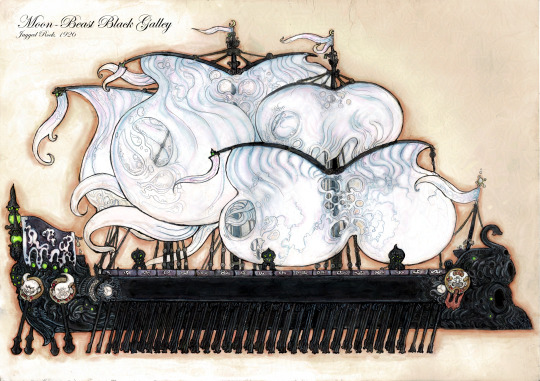
The black galleys from the moon of the dreamlands; these come to trade rubies for gold and the enslaved; their rowers are never seen, and the merchants with too-wide mouths and curious shoes have an evil mien. A terrible stench arises from those awful timbers, but men yet tolerate them for the jewels they bring. For this, I mixed together features of classical and Renaissance galleys, along with sails based on the forms of jellyfish (Jordan Peele's Nope really got into my head there!);-I think they twist and raise and lower and fill of their accord. The onion-dome towers along the deck are based on ones used on warships of the classical world; archers and slingers can sweep the decks of boarders from these vantage points, although the hideous denizens of the moon have not had to fight in a long time.
#cthulhu mythos#lovecraft#my art#cthulhu#dreamlands#dream quest of unknown kadath#weird fiction#moon beast#pulp fiction#pulp illustration#horror#cosmic horror
32 notes
·
View notes
Text
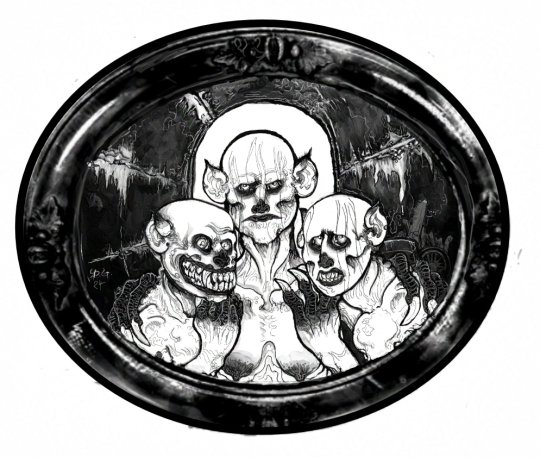
A portrait of an American family.
This is a piece for the upcoming indie Call of Cthulhu module "Somebody Think of the Children"- ghouls, goths, LARPING and the Satanic Panic come to the 90's bible belt.
Links here!
6 notes
·
View notes
Text
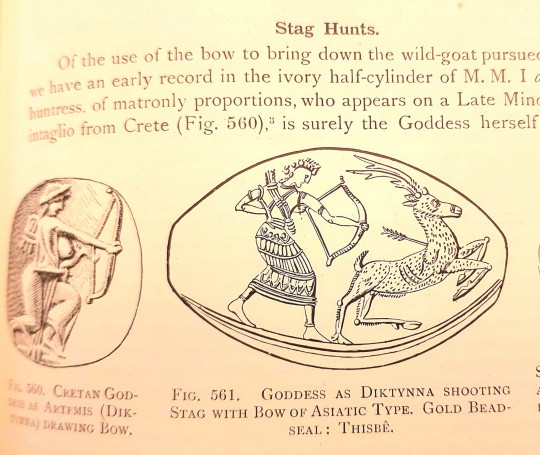
For your perusal and enjoyment; Minoan sealstones from Knossos, seeming to show an Artemis or an Atalanta sort of figure.
Or, well, some completely different lady archer with nice cans motif we don't understand because we can't read Linear A.
This is from an early 1900s copy of Arthur Evans' books on his excavations at Knossos. He's a sucker for incredibly obvious fakes like the Boston snake goddess, and really reaches to see scenes from later Greek myth in seal-stones- but he shows a lot of material that seems to have fallen out of circulation in later books that just seem to summarise each other.
#minoan#mythology#artemis#atalanta#greek mythology#bronze age#knossos#arthur evans#archaeology#ancient civilizations
29 notes
·
View notes
Text

Clytaemnestra's Aristeia
Agamemnon, feasted and wined and bathed into stupour, is at last killed by Clytaemnestra, like a sacrificial ox; Iphigenia is avenged. Cassandra, Elektra, and Orestes will all pay for Agamemnon's offenses. (I'm on team Clytaemnestra did quite a bit wrong here, classics fans, for all that Agamemnon had it coming)
Aegisthus either helps out or does the deed in various versions, but I didn't feel like this was really about him all that much.
Clytaemnestra has a well, mostly Mycenean get-up, but I'm afraid I cheated a bit with a Minoan apron, and creative license with use of hair ornaments and a rather speculative belt. Illustratively I prefer the more structured and fitted approach of earlier illustrations; I think Bernice Jones' looser reconstructions are probably more on the money, although I strongly suspect that a lot of the later flounced skirts are really culottes.
#greek mythology#mythology#pen and ink#my art#mycenaean#minoan#clytemnestra#agamemnon#classics#historical costume#greek tragedy
62 notes
·
View notes
Text
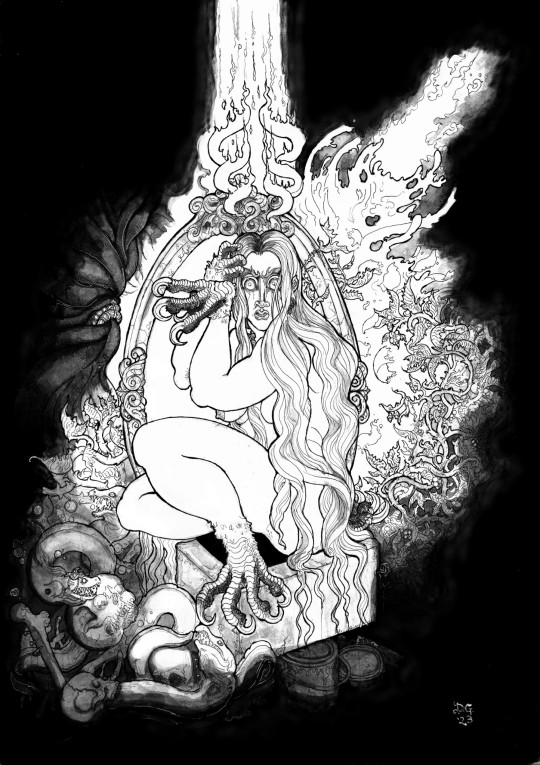
A cover for Fire of the Mind poetry journal.
13 notes
·
View notes
Text

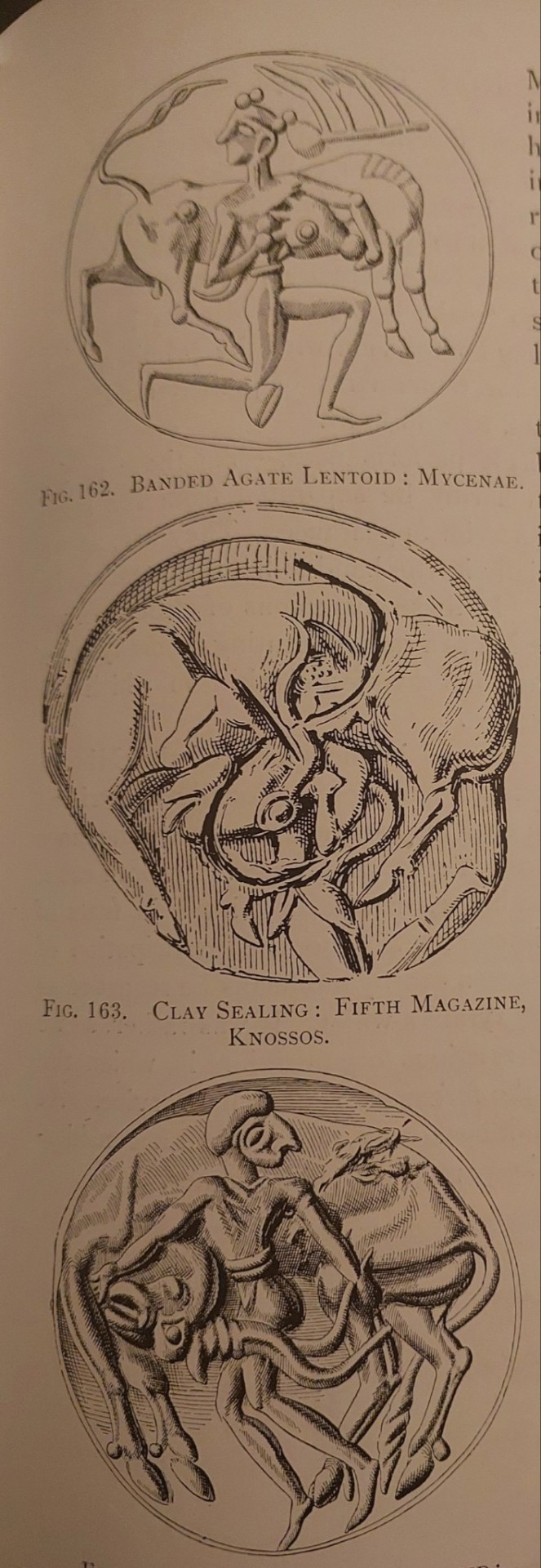


Sometimes, the bull-leaping works. Sometimes, you eat shit and somebody makes a seal-stone out of it.
(From a hundred year and change-old copy of Arthur Evans' "The Palace of Minos at Knossos"; his notes on his (rather ghastly) excavation of Minoan ruins in Crete.)
#minoan#greek mythology#antiquity#classics#bull leaping#bronze age#ancient civilizations#archaeology
111 notes
·
View notes
Text
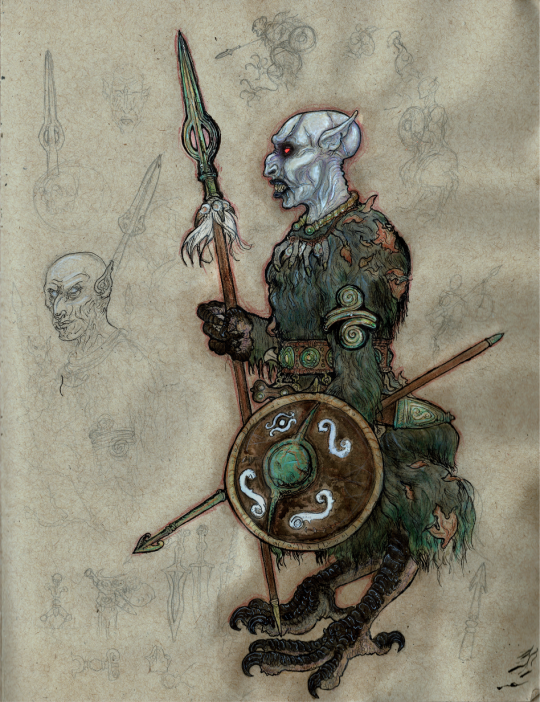

Bodachs, from Alan Garner's YA fantasy book The Moon of Gomrath. They were smaller than Susan, a young adolescent; bald, pointy-eared, covered in flat locks of hair like scales, had the legs of birds and bounded along with an unpleasant pecking motion. They served Morrigan, living only for the scream of blades.
The dwarf Uthecar described them as much like Goblins, but, loath as he was to admit it, braver, more aggressive. They stuck with me from reading that book a long time ago. I remembered their spears and odd legs, but falsely recalled horns and scaled armour, because these things are tricky.
I've settled on some raven or crow forms in their kit, and let them have the lamprey as a favourite animal motif. In the story, they can be eerily still and hard to detect; I decided their fur should accumulate algae and leaf litter like a loth to help them along with this.
I had a lot of fun with these nasty little men, and got to horse around with some new digital tricks. Like them!
#my art#The Moon of Gomrath#Weirdstone#Weirdstone of Brisingamen#Fantasy#Monster#Bodach#Goblin#Alan Garner#fae
51 notes
·
View notes
Text




Well, I think I got it sort of okay!
17 notes
·
View notes